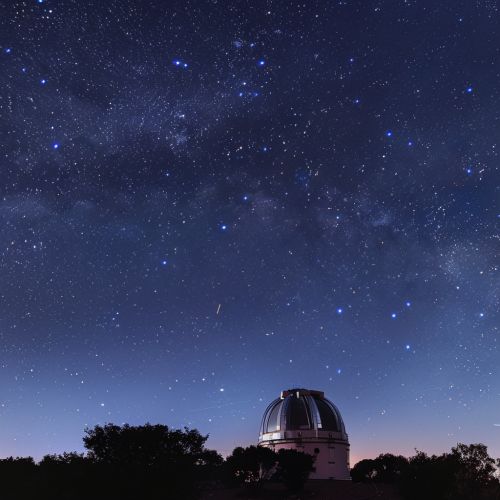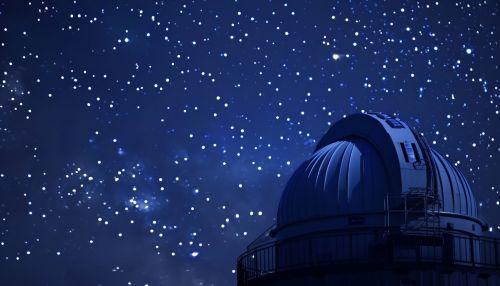American Astronomical Society: Difference between revisions
(Created page with "== History == The AAS was founded in 1899 by astronomer George Ellery Hale, who also played a significant role in the establishment of other major scientific institutions. The society was originally named the Astronomical and Astrophysical Society of America, but it was renamed to its current title in 1915. The AAS was created to promote the advancement of astronomy and closely related branches of science. == Mis...") |
No edit summary |
||
| Line 63: | Line 63: | ||
== Image == | == Image == | ||
[[Image:Detail-91753.jpg|thumb|center|An image of a large astronomical observatory with a clear night sky full of stars.|class=only_on_mobile]] | |||
[[Image:Detail-91754.jpg|thumb|center|An image of a large astronomical observatory with a clear night sky full of stars.|class=only_on_desktop]] | |||
== See Also == | == See Also == | ||
Latest revision as of 19:41, 19 June 2024
History
The AAS was founded in 1899 by astronomer George Ellery Hale, who also played a significant role in the establishment of other major scientific institutions. The society was originally named the Astronomical and Astrophysical Society of America, but it was renamed to its current title in 1915. The AAS was created to promote the advancement of astronomy and closely related branches of science.
Mission and Objectives
The primary mission of the AAS is to enhance and share humanity's scientific understanding of the universe. This mission is pursued through various objectives, including:
- Promoting original research in astronomy and astrophysics.
- Disseminating research findings through publications and meetings.
- Fostering education in astronomy at all levels.
- Advocating for policies that support scientific research and education.
- Encouraging the development of observational and theoretical techniques.
Membership and Structure
The AAS is composed of individual members who are professional astronomers, students, and amateur astronomers. Membership categories include Full Members, Junior Members, and Affiliate Members. The society is governed by an elected council, which includes a president, vice-presidents, and other officers.
The AAS is organized into several divisions, each focusing on a specific subfield of astronomy. These divisions include:
- The Division for Planetary Sciences (DPS)
- The High Energy Astrophysics Division (HEAD)
- The Solar Physics Division (SPD)
- The Division on Dynamical Astronomy (DDA)
- The Historical Astronomy Division (HAD)
Publications
The AAS publishes several prestigious journals that are essential resources for the astronomical community. These include:
- The Astronomical Journal (AJ), which focuses on significant research in astronomy.
- The Astrophysical Journal (ApJ), which covers all aspects of astrophysics.
- The Astrophysical Journal Supplement Series (ApJS), which publishes extensive data sets and detailed research.
- The Bulletin of the American Astronomical Society (BAAS), which includes meeting abstracts and reports.
Meetings and Conferences
The AAS organizes two major meetings each year, known as the winter and summer meetings. These meetings are among the largest gatherings of professional astronomers in the world. They feature scientific sessions, poster presentations, workshops, and plenary talks by leading researchers.
In addition to the general meetings, the AAS divisions hold specialized meetings that focus on their respective fields. For example, the DPS holds an annual meeting dedicated to planetary science.
Advocacy and Public Policy
The AAS actively engages in advocacy efforts to support scientific research and education. The society works with government agencies, policymakers, and other organizations to promote policies that benefit the scientific community. Key areas of advocacy include funding for astronomical research, support for space missions, and education initiatives.
Education and Outreach
The AAS is committed to promoting education and public outreach in astronomy. The society supports various programs and initiatives aimed at enhancing science education and inspiring the next generation of astronomers. These efforts include:
- Providing resources and support for educators.
- Organizing public lectures and events.
- Supporting amateur astronomy groups.
- Developing educational materials and curricula.
Awards and Honors
The AAS recognizes outstanding contributions to the field of astronomy through various awards and honors. Some of the most prestigious awards include:
- The Henry Norris Russell Lectureship, awarded for lifetime achievements in astronomy.
- The Newton Lacy Pierce Prize, awarded to young astronomers for outstanding achievements.
- The Beatrice M. Tinsley Prize, awarded for outstanding research contributions.
Image


